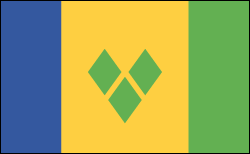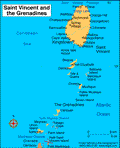- / World & News
- / Countries of the World
- / St. Vincent and the Grenadines
St. Vincent and the Grenadines

Index
- St. Vincent and the Grenadines Profile
Geography
St. Vincent, chief island of the chain, is 18 mi (29 km) long and 11 mi (18 km) wide and is located 100 mi (161 km) west of Barbados. The island is mountainous and well forested. St. Vincent is dominated by the volcano Mount Soufrière, which rises to 4,048 ft (1,234 m). The Grenadines, a chain of nearly 600 islets with a total area of only 17 sq mi (27 sq km), extend for 60 mi (96 km) between St. Vincent and Grenada. The main islands in the Grenadines are Bequia, Balliceau, Canouan, Mayreau, Mustique, Isle D'Quatre, Petit Saint Vincent, and Union Island.
Government
Parliamentary democracy.
History
The Carib Indians inhabited St. Vincent before the Europeans arrived, and the island still sports a sizable number of Carib artifacts. Explored by Columbus in 1498, and alternately claimed by Britain and France, St. Vincent became a British colony by the Treaty of Paris in 1763. In 1773, the island was divided between the Caribs and the British, but conflicts between the groups persisted. In 1776, the Caribs revolted and were subdued. Thereafter the British deported most of them to islands in the Gulf of Honduras. Sugarcane cultivation brought thousands of African slaves and, later, Portuguese and East Indian laborers.
The islands belonged to the West Indies Federation from 1958 until its dissolution in 1962, won home rule in 1969 as part of the West Indies Associated States, and achieved full independence Oct. 27, 1979. Prime Minister Milton Cato's government quelled a brief rebellion on Dec. 8, 1979, attributed to economic problems following the eruption of Mount Soufrière in April 1979 (which had caused the evacuation of the northern two-thirds of the island). The eruption, followed by Hurricane Allen in 1980, seriously damaged the nation's economy, particularly the important banana crop, in the 1980s. But by the 1990s the economy had begun to rebound. With the 1999 decision by the European Union to end its preferential treatment of bananas imported from former colonies, St. Vincent sought to diversify its economy, primarily through expanding tourism.
In 2001 elections, the Unity Labour Party (ULP) won a landslide upset, and Ralph Gonsalves, a lawyer, became the new prime minister. In 2005, he was reelected.
See also Encyclopedia: St. Vincent and the Grenadines .
U.S. State Dept. Country Notes: Saint Vincent and the Grenadines

